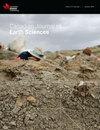不列颠哥伦比亚东南部Omineca带南Purcell背斜的构造、变质作用和云母40Ar/39Ar热年代学及其向中央Kootenay弧的过渡
IF 1.6
4区 地球科学
Q3 GEOSCIENCES, MULTIDISCIPLINARY
引用次数: 1
摘要
珀塞尔背斜(PA)和库特尼弧(KA)是加拿大科迪勒拉奥米内卡带东南部两个相邻的中生代构造域。中元古代的Belt-Purcell超群(BPSG)以PA为核心,具有开阔的上向构造。BPSG (Aldridge组)深层保存了中元古代千层解理(S1)和黑云母带矿物组合。KA位于PA西侧,具有较年轻的新元古代-古生代地层。本研究重点研究的KA中部,经历了早白垩世韧性变形(S2片岩)和巴罗维变质作用叠加的侏罗纪卧位褶皱和绿片岩相变质作用。将PA和KA之间的界面作为S2片岩的最东端产状。PA的K-Ar和40Ar/39Ar云母年龄在1318 ~ 240 Ma之间,空间分布不一致。它们被解释为反映了中元古代初始冷却后Ar的部分重置,表明PA在较年轻的构造运动中没有得到充分的埋藏或加热,以均匀地重置云母冷却时代。KA期40Ar/39Ar的年代范围为139 ~ 55 Ma,反映了已有文献记载的中、新生代变质作用、岩浆作用和挖掘作用。PA-KA界面位于Laurentian基底向西倾斜的斜坡上方。在早白垩世的挤压造山运动中,PA中厚的中元古代浊积岩和岩质层序可能起到了坚硬的支撑作用,使得KA中部较韧性的岩石在其上“堆积”。本文章由计算机程序翻译,如有差异,请以英文原文为准。
Structure, metamorphism, and mica 40Ar/39Ar thermochronology of the southern Purcell anticlinorium and its transition into the central Kootenay arc, Omineca belt, southeastern British Columbia
The Purcell anticlinorium (PA) and the Kootenay arc (KA) are two adjacent Mesozoic tectonic domains in the southeastern Omineca belt of the Canadian Cordillera. Mesoproterozoic rocks of the Belt-Purcell Supergroup (BPSG) core the PA and have open, upward-facing structures. Deeper levels of the BPSG (Aldridge Formation) preserve a Mesoproterozoic phyllitic cleavage (S1) and biotite zone mineral assemblages. The KA, on the west flank of the PA, has a younger Neoproterozoic through Paleozoic stratigraphy. The central part of the KA, the focus of this study, experienced Jurassic recumbent folding and greenschist facies metamorphism that was overprinted by Early Cretaceous ductile deformation (S2 schistosity) and Barrovian metamorphism. The interface between the PA and KA is taken as the easternmost occurrence of the S2 schistosity. K–Ar and 40Ar/39Ar mica dates in the PA range from 1318 to 240 Ma and show no consistent spatial distribution. They are interpreted to reflect partial resetting of Ar following initial cooling in the Mesoproterozoic, indicating that the PA was never sufficiently buried or heated during younger tectonism to uniformly reset the mica cooling ages. In the KA, 40Ar/39Ar dates range from 139 to 55 Ma and reflect previously documented periods of Mesozoic and Cenozoic metamorphism, magmatism, and exhumation. The PA–KA interface occurs above a west-dipping ramp in the Laurentian basement. The thick Mesoproterozoic sequence of turbidites and sills in the PA may have acted as a rigid buttress against which the more ductile rocks of the central KA “piled up” during Early Cretaceous compressional orogenesis.
求助全文
通过发布文献求助,成功后即可免费获取论文全文。
去求助
来源期刊

Canadian Journal of Earth Sciences
地学-地球科学综合
CiteScore
2.80
自引率
7.10%
发文量
66
审稿时长
6-12 weeks
期刊介绍:
The Canadian Journal of Earth Sciences reports current research in climate and environmental geoscience; geoarchaeology and forensic geoscience; geochronology and geochemistry; geophysics; GIS and geomatics; hydrology; mineralogy and petrology; mining and engineering geology; ore deposits and economic geology; paleontology, petroleum geology and basin analysis; physical geography and Quaternary geoscience; planetary geoscience; sedimentology and stratigraphy; soil sciences; and structural geology and tectonics. It also publishes special issues that focus on information and studies about a particular segment of earth sciences.
 求助内容:
求助内容: 应助结果提醒方式:
应助结果提醒方式:


